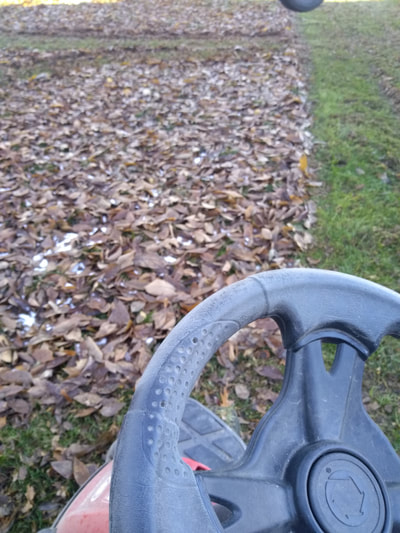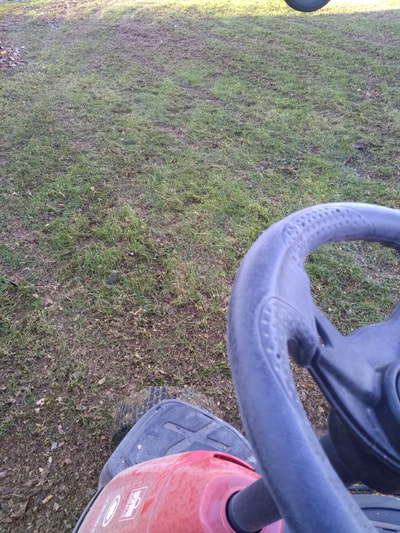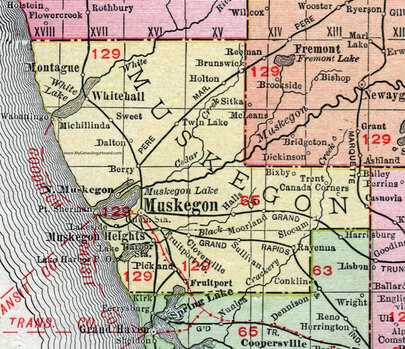 Good news, Muskegon County residents! Good Sweet Earth isn't just serving the counties of Kent, Allegan and Ottawa anymore. Starting in 2019, we're expanding our service area north along the lakeshore to cities and townships in Muskegon County. If you live in Muskegon, Norton Shores, Whitehall, Roosevelt Park, Casnovia, Fruitport, Montague, Ravenna, or any neighboring community, and you'd like to feed your turf and soil organically, we'd love to come out and give you a free consultation for lawn care. But why go organic on your lawn? First, healthy grass comes from healthy soil. Synthetic chemical fertilizers kill your soil, which in turn kills your turf and makes it overly reliant on chemicals. Dead soil is also a breeding ground for weeds and disease. Organic fertilization focuses on feeding your soil and developing a healthy ecosystem of bacteria, fungi, worms and other life below the surface of your yard. We use vermicompost (nutrient-rich compost made by earthworms), microbial tea (a liquid rich in microbes to help break down organic matter in your soil), and all-natural slow-release fertilizers. Second, many people in the United States have made the switch to buying organic produce, yet continue to dump chemicals on their lawn and garden. There's a real disconnect there. If you're concerned with how your food is grown on a farm, you should be even more concerned with how your grass (and garden) are grown in your own yard. Third, synthetic chemicals are destroying our ecosystem. These chemicals leach into our watersheds, they kill the life found in our lakes, rivers and streams, they cause algae blooms, and ultimately introduce poisons into our environment. Organic soil management practices can reduce the effects of climate change by helping soil hold on to carbon more effectively. This type of healthy soil management doesn't have to be limited to farms, it needs to start right in each of our yards. In fact, lawns cover more acreage in the United States than any other crop. That means the management practices adopted by homeowners could have a larger impact on our nation's soil and climate than the actions of our farmers. If you live in Kent, Ottawa, Allegan or Muskegon Counties in West Michigan, and you'd like to learn more about organic lawn care for your own home, give us a call at 616-594-0693 or email us at office@GoodSweetEarth.com.
0 Comments
If you can remember back to this spring, you'll recall we had some very cold, icy weather well into April. That late blast of winter pushed the spring bloom back a couple weeks for a lot of plants, including for our magnolia tree.
It seems that magnolia wanted to get all it could out of this season since it got such a late start on things, because it also decided to drop its leaves late this year too. Today I was finally able to take care of those leaves. And it was a great day for my lawn. I always tell anyone who will listen that they should mulch mow their lawn, all season long. That means, from the first mow of spring through the final leafy mow of the fall, take that bag off your mower and let those clippings stay on your lawn. Making sure you mulch those leaves in the fall (instead of raking them up) is especially important, because they do so much for your turf. First, those mulched leaves provide a home for critters-- both the macrobial and microbial populations in your yard. They allow beneficial bugs and fungi and bacteria and other critters to overwinter more effectively. A healthy turf relies on those living things, so we should be doing everything we can to make sure they're taken care of on our lawns. Second, those mulched leaves are nature's fertilizer. They break down and release nutrients into the soil which your lawn needs for growth. Then as they break down, they turn into compost for your soil. Soil with a healthy level of compost (organic matter) holds both water and nutrients more effectively, which helps your lawn stay healthy all year long (even in the blazing hot summer and frigid winter). Finally, those mulched leaves serve as insulation for your turf over the winter. Think of that thin layer of chopped up leaves as a blanket for your yard, which means your grass won't suffer as much through the harsh west Michigan winter. In some cases, you may have to run your mower over those leaves two or three times to get the particles small enough for you to be comfortable with. But the extra bit of mowing will be worth it in the spring. In some parts of our yard, I don't even bother to mulch the leaves. I just let them overwinter at full-size, and then in the spring I mulch them up for an early-season lawn feeding. If you've got a smaller yard, or neighbors who might cast judgement upon you, I don't recommend just leaving the leaves, however. Mulch 'em. But if you've got areas of your yard where you just don't care about a little unsightly leaf cover, I say let them go until April. They'll do what nature intended: Cover and feed the soil. (One word of warning: If you've got a really thick leaf cover on your lawn, or you've got big heavy leaves, like from a magnolia tree, you're gonna want to do at least one pass with the mower, otherwise the blanket will be too thick, and may smother your grass or encourage mold.) 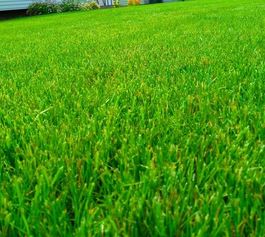 Since autumn is just around the corner, that means your lawn’s growing season is just around the corner as well. You may have noticed your grass slows down during the summer months—it doesn’t grow as fast, which means less mowing, and it often takes on a brownish hue, some might even call it “crispy.” This, of course, is completely normal for Michigan lawns. The hot summer months are the dormant period for cool-weather grasses. But as the daytime temps dip into the 70s more regularly, and precipitation picks up, you can expect your lawn to start “growing and greening” again. With that, there are some things you can do to make your lawn healthier and thicker. 1. Fall is a great time to fertilize. Good Sweet Earth applies organic fertilizer (an alfalfa blend fertilizer) twice a year: in spring and fall. If you were going to only apply fertilizer one time a year, I recommend fall over spring. Why? A few reasons: First, fall fertilization gives your lawn some nutrients before the long, harsh winter. This will make it less distressed when spring rolls around. It also adds organic matter to your soil to help insulate the roots a bit. Second, if you’re applying slow-release organic fertilizer, it won’t break down entirely before winter sets in, which means there will likely be some semi-composted product still on your lawn in the spring; it’s sort of an early spring meal for your lawn which will help green it up early and get it growing strong. Finally, there are less weeds germinating in the fall, which means the nutrients you put in your soil will be more available for your grass, instead of those nasty invasive plants you’d rather not be fertilizing. If you're interested in having us apply some alfalfa blend fertilizer to your lawn, get in touch. 2. Fall is the ideal time to overseed. Like fertilizing, you can overseed in either spring or fall. I prefer late summer/early fall because your grass seeds won’t be competing for space with weed seeds as much. Those gaps in your lawn where grass isn’t growing are prime real estate for weeds. But as your soil gets healthier from organic lawn treatments, those gaps will fill in with grass—unless weeds get there first! In the fall, there are less weed seeds looking for a home, so putting grass seed down in late-August or earl-September (you could do it as late as the first part of October, especially if we have a warm fall) will ensure the grass has a head start over the weeds come spring. To overseed, first, mow your grass lower than you normally would; if the clippings are especially long or clumpy, rake them up so the seed can fall easily to the soil below. Second, buy a sun/shade mix and apply it with a spreader or scatter it evenly by hand. The rate you should be applying is typically 4-6 pounds per 1000 square feet (a 10,000 square foot turf space should be overseeded with about 50 pounds). For bare spots in your lawn: Mix the seed with a little potting soil (soil + compost) and apply it directly as a patch. If rain’s not in the forecast, water it regularly. Every year you do this will mean thicker and less weedy turf. 3. If you’re going to aerate your lawn, do it in fall. Summer is a bad time for aeration simply because you don’t want to distress your lawn any more than you have to during its dormancy. In fall, the grass is growing strong and can recover better from the aeration process. If you’re going to aerate, either hire a company to do core aeration (pulling plugs of soil out of the ground), or rent a core aeration machine and do it yourself. Do NOT succumb to the idea of putting spikes on your shoes and walking around your yard. That simply compacts the soil further. To properly aerate, you need to pull plugs out of the ground so that water and air can get in. Poking holes with spikes won’t do that. That being said, aeration is typically only necessary once every few years, and usually only with over-chemicaled yards. When soil is healthy, full of microbes, worms, bugs and organic matter, it doesn’t need core aeration—the worms and bugs and microbes aerate it for you.  I’ve always been a big supporter of the idea that a weed is only a misplaced plant. That is, if the presence of dandelion, clover, or even Canadian thistle don’t bother you, they’re not weeds. In fact, let’s focus on clover for a minute. Before our nation became so dependent upon chemical lawn treatments (and we were sold the lie that our lawns are only attractive as a pristine monoculture), clover was actually added to grass seed mixes. And when you think about it, even aesthetically, what’s wrong with a little (or a lot of) clover in your lawn? It’s green, it covers the ground evenly, and it holds up well in high-traffic and drought-like conditions. Plus the little white (or red) flowers give a beautiful contrast to your green lawn. In an article on HGTV.com, Master Gardener Paul James talks about clover’s biological benefits too: Here are his top three reasons for loving clover: 1. Clover is a legume, meaning it fixes nitrogen from the air and puts it into the soil. "It's an amazing chemical process, one that reduces the need for additional nitrogen from fertilizers. In fact, clover seed used to be added to turf grass mixtures to help the grass become established faster." 2. Rabbits love eating clover, so if you want to deter rabbits from eating something more precious in the garden, you can try offering them clover. 3. Clover attracts earthworms "by the gazillions," Paul says, "and we all know how beneficial earthworms are for the health of the soil and the plants that grow in and on it." James also talks about how having a monoculture (only one type of plant) in your lawn is bad, and that having a smattering of other stuff (what the chemical industry would call “weeds) is not only tolerable,, but a good thing. In fact, about 15% of his lawn contains things besides grass—things like clover. Having biodiversity in your lawn, he says, reduces disease and harmful pest infestation, plus it attracts beneficial insects (like bees). But probably one of the most important reasons for welcoming biodiversity is that it will reduce, or even eliminate, the need for harmful herbicides, fertilizers and pesticides in our soil. Before the chemical industry told us we needed monoculture lawns, people’s lawns were just healthy, beautiful and natural places to spend time in the summer. Now, we’ve got caution signs keeping us off, polluted soil producing dead spots, and the need for monocultures causing stress and anxiety. So I say to you: Relax, welcome some diversity to your lawn this year and know that you’re doing exactly what nature wants. Both you, and your yard, will be happier and healthier. Looking to buy some clover seed? We've got it! Uninoculated and organic. 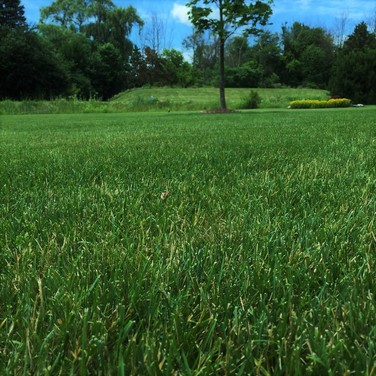 A couple weeks ago, I taught a class at Meijer Gardens in Grand Rapids on eco-friendly lawns. I have to say, preparing to teach a class on your life’s work really helps you organize your thoughts and mission. I came out of this experience with a clearer understanding of, not just how I approach organic lawn care, but why I do it the way I do. I’ve always thought of myself as a “lawn guy.” I’m certified in lawn care management through the University of Georgia, I’ve joined the National Association of Landcare Professionals (NALP), and I help people get their turf strong and healthy. That would fit most people’s definitions of “lawn guy.” But after doing this class at Meijer Gardens, I realized I’m not so much a “lawn guy” as I am a “soil guy.” But the two aren’t mutually exclusive. If you’re a lawn guy without also being a soil guy, you’re potentially doing long-term damage to the turf (not to mention the planet). If a lawn guy is simply interested in getting your lawn green and weed-free in a matter of days, with no concern for the health and fertility of the soil below, your lawn’s going to suffer. Applying synthetic chemical fertilizers and herbicides kill the soil, plain and simple. But as a lawn guy, who’s also primarily a soil guy, I’m more interested in creating healthy soil—full of microbes, worms, beetles, organic material, nutrients that don’t leach away—than I am in making your lawn instantly green and weed-free. Healthy soil will give you healthy turf. Dead soil will give you, well, dead turf. Now don’t get me wrong, I’m still interested in giving people a lawn that’s green and relatively “weed free,” but there’s no magic instantaneous potion that can do that while NOT killing the soil, and don’t let anyone tell you otherwise. And that’s why I am so passionate about feeding the soil, rather than the grass. That’s how nature’s been doing it for millennia. Soil damaged by synthetic chemicals will ultimately give you weak turf and “dead zones” where weeds pop up and grass just doesn’t grow… and then the chemical lawn guys will tell you how much you need them to get your lawn looking good again. And it’s true, in a twisted way—through chemicals, they’ve created a lawn that is wholly dependent upon more environmentally-damaging chemicals for its survival. But what your lawn really needs is healthy soil. Healthy soil will give you healthier, stronger turf. Healthier, stronger turf will push out those pesky plants we know as weeds. And that’s why my focus is to give our customers healthy soil—by feeding your soil with microbes, compost, natural fertilizers like alfalfa and kelp. So when I work on a lawn, I’m doing it as a “soil guy” first and foremost. And when you take care of the soil, your lawn is actually sustainable and healthy, not dependent and weak. If you'd like to have Good Sweet Earth give you a healthier lawn by improving your soil, get in touch with me at Steve@GoodSweetEarth.com or call us at 616-594-0693. |

